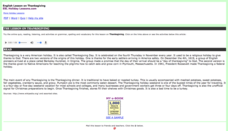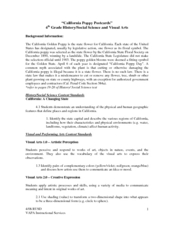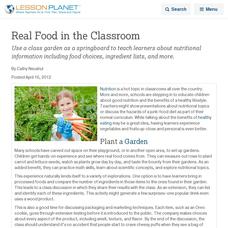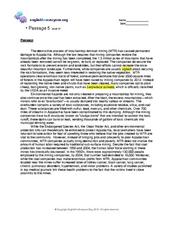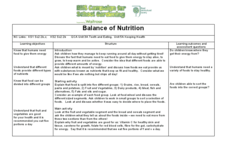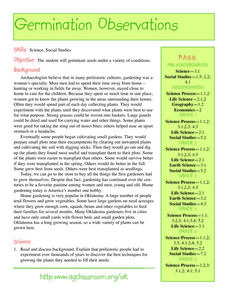Curated OER
LP 6--8: Xenopus laevis (frog) Development for a 7th Grade Audience
Seventh graders view lab stations with Xenopus at different stages of development. They identify the life stage of the sample, as well as the previous and next stages. Students must explain their reason for selecting the specific stage.
ESL Holiday Lessons
Thanksgiving
Near Thanksgiving, learners complete activities surrounding the holiday. Some of the activities include a passage, matching phrases, fill in the blanks, correct word choosing, multiple choice, sequencing, unscramble the sentences, write...
Curated OER
California Poppy Postcards
What a great lesson! Learners discuss California history, including the state flower, the poppy, and then engage in an art activity. For the activity, they learn about value, shading, layering, blending etc. to produce a realistic...
Curated OER
The Verb
How are linking verbs and action verbs different? First, study the definitions and examples of each (at the top of the first page). Then, assess the comprehension skills of your class by having them complete the 20-question practice...
May Media Group
Treatment Plants
Young scientists explore nature's water treatment plants in this simple science demonstration. By placing a stalk of celery in a cup of water mixed with food coloring, children are able to observe how plants absorb nutrients and...
It's About Time
Effects of Plate Tectonics
Explore our world from within as you lead young scientists on a thrilling adventure. Pupils examine the location of plate boundaries to determine earthquake and volcano distribution around the globe and explore the cause of hot spots in...
Virginia Department of Education
Meiosis
Intrigue the class by completing a lesson on meiosis, filled with challenging and insightful activities to spark the interest of every person in the room. Each member of the class learns about genetic disorders due to faulty meiosis, and...
Curated OER
Real Food in the Classroom
Use a class garden to teach learners about real food, nutrition, and more.
K12 Reader
Natural Resources
What natural resources are available in your area? Your learners can consider this question after reading a brief passage about natural and renewable resources. After reading, class members respond to five questions related to the reading.
Curated OER
Student Handout 6D: Trail of the Tomato: Group D: Labor Contractors
A research project that concludes with a visual and written presentation. This is all about the tomato and how it relates to the lives of migrant workers, labor contractors, and industrial agriculture. This is a group project that is...
Curated OER
Reading Comprehension 5: Level 10
Whether used as a reading comprehension assessment, as the basis of a mini-lesson on reading strategies, or as extra practice, this exercise will prove to be valuable because of the answers and explanation key that accompanies the...
Teachnology
Paragraph Review
Writers are asked to examine four sentences that contain details and craft a topic sentence for a paragraph that encapsulates the main idea.
K12 Reader
Taiga Ecosystems
After reading a short article about taiga ecosystems, middle schoolers are asked to identify the characteristics of this chilly environment.
Ask a Biologist
The Many Faces of Ants
Though they be but little, they are fierce! Young biologists read about eight different species of ants, and discover how the anatomy of their heads can explain the way they live and what they eat.
Chicago Botanic Garden
Plant Phenology Data Analysis
Beginning in 1851, Thoreau recorded the dates of the first spring blooms in Concord, and this data is helping scientists analyze climate change! The culminating instructional activity in the series of four has pupils graph and analyze...
California Academy of Science
Exploring the Impacts of Feeding the World
Approximately 50 percent of people in the world who are chronically hungry work in agriculture. While it seems counter-intuitive, the farther you live from a farm, the more food options are available. Scholars explore concepts related to...
Curated OER
Balance of Nutrition
Students explore nutrition by completing a group activity. In this balanced meal lesson, students identify the five food groups and discuss their favorite foods from each group. Students utilize illustrations to fill in a fictional plate...
Curated OER
Where in the World?
Learners evaluate botany by participating in a class discussion. In this agriculture lesson, students identify the importance of knowing where food comes from and they discuss what their breakfast consisted of and where it came from....
Curated OER
Does turnip curling always cause friction?
Third graders become familiar with the effects of force through curling. In this turnip curling instructional activity, 3rd graders experiment with a turnip curling stone on various surfaces. Students are assess with a new variable...
Curated OER
Germination Observations
Students germinate seeds under a variety of conditions. First, students read and discuss the background of gardening. After reviewing germination and the steps to the scientific method, groups of students complete experiments.
Curated OER
A Seed Dispersal Investigation
Students investigate the function and purpose of seed dispersal. In this garden lesson plan, students examine the importance of wind in the plant cycle. Students construct a flying seed model from an attached design and discuss if it can...
Curated OER
Stative Verbs Worksheet-Exercise 1
In this present simple and present continuous verbs activity, students examine 21 sentences and fill in the blanks in each by putting the verb in parentheses into the present simple or present continuous verb tense.
Curated OER
Using Sterile Techniques as a Tool in Studying Plant Diseases
Seventh graders examine the concept of sterile techniques. They realize that plant diseases can be identified and classified in various way. Students identify some of the diseases that attack the garden plants.
Curated OER
Vegie Gardening
Students investigate the concept of Veggie Gardening and develop the plans for a successful yield of crops. They answer some practical questions and then apply the information to the horticulture garden. The project includes finding the...

